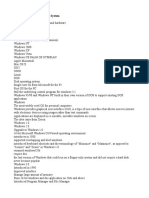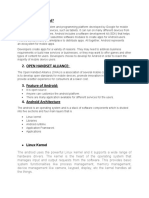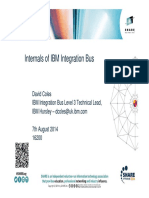Microsoft OS
Microsoft OS
Uploaded by
Jessica Sidra RaeCopyright:
Available Formats
Microsoft OS
Microsoft OS
Uploaded by
Jessica Sidra RaeOriginal Description:
Copyright
Available Formats
Share this document
Did you find this document useful?
Is this content inappropriate?
Copyright:
Available Formats
Microsoft OS
Microsoft OS
Uploaded by
Jessica Sidra RaeCopyright:
Available Formats
Microsoft Windows Operating Systems Timeline Name Date Description It is based on text commands - users needed Aug.
25, to enter manual commands at the C: prompt Ms- Dos 1981 to run applications and open folders. Personal Computer (PC). Had a graphical user interface that allowed Nov. 20, people to run programs with a simple mouse Windows 1985 click on an icon rather than relying on the MSDOS method of typing text commands It is a 16-bit operating system. Designed to run on the Intel 286 processor- allowed a desktop Windows Dec. 9, computer to have an expanded memory, so 2.0 1987 that people could run overlapping windows on the screen something not possible in the first version of Windows. It is a 16-bit operating system designed for the Windows May 22, Intel 386 processor. New features including 3.0 1990 the program manager and the file manager. It is a 32-bit operating system that ran on more Windows NT Jul. 27, powerful computers with larger memories. It 3.1 1993 was aimed primarily at business customers rather than consumers. Windows for Workgroups Windows 95 Windows NT 4.0 Windows CE Aug. 11, 1993 Aug. 24, 1995 Feb. 21, 1996 Nov. 11, 1996 It is an upgrade to windows 3.1 peer to peer file sharing. Made it easier for consumers to install new hardware and software. Had an increased ease of use and simplified management, higher network throughput, and tools for developing and managing intranets. First in a series of compact and portable OS for devices. Has been used in handheld PCs, to wireless communications devices such as digital information pagers and smartphones. Users find information more easily on their PCs, as well as the Internet. Other ease-of-use improvements included the ability to open and close applications more quickly, support for reading DVD discs and USB devices. Offered a variety of new and enhanced hardware compatibility and Internet-related features.
Windows 98
Jun. 25, 1998
Windows Second Edition
May 5, 1999
Windows Professional Windows ME Windows XP Windows Server w/ 6 Editions Windows Vista Window Home Server Windows Server 2008
Feb. 17, 2000 Sept. 14, 2000 Oct. 25, 2001 Apr. 25, 2003 Jan. 30, 2006 Nov. 7, 2007
An upgrade to Windows NT Workstation 4.0.Also designed to replace Windows 95, Windows 98, and Windows NT Workstation 4.0 on all business desktops and laptops. Offered numerous music, video, and home networking enhancements and reliability improvements. Enhanced user experience. Professional Home 64 Bit Media Centre Web Edition (32-bit) Standard Edition (32 and 64-bit) Enterprise Edition (32 and 64-bit) Datacenter Edition (32 and 64-bit) Small Business Server (32-bit) Enhanced security by introducing a new restricted user mode called User Account Control. Can be configured and monitored using a console program that can be installed on a client PC. Features: Media Sharing, local and remote drive backup and file duplication Builds on the technological and security advances first introduced with Windows Vista, and is significantly more modular than its predecessor, Windows Server 2003. Advances in touch and handwriting recognition. Support for virtual hard disks, improved performance on multicore processors, improved boot performance, Direct Access, and kernel improvements Has a faster startup through UEFI integration and the new "Hybrid Boot" mode (hibernates the Windows on shutdown). new lock screen with clock and notifications, ability to create live USB versions of Windows (Windows To Go). Adds native support for USB 3.0 devices. A user can now log in to Windows with a Microsoft account, Windows Live ID -used to access services and synchronize applications and settings between devices.
Feb. 27, 2008
Windows 7
Jul. 22, 2009
Windows 8
Oct. 26, 2012
You might also like
- Evolution of Windows Operating SystemDocument16 pagesEvolution of Windows Operating SystemphexiiNo ratings yet
- Ictnwk420 Install and Configure Virtual MachinesDocument68 pagesIctnwk420 Install and Configure Virtual Machinessanthosh kumarNo ratings yet
- CWS 315 2I en StudentManual 4 5 Days v02Document600 pagesCWS 315 2I en StudentManual 4 5 Days v02Onurcan YahyaoğluNo ratings yet
- Operating Systems CourseworkDocument61 pagesOperating Systems CourseworkEkode JoshuaNo ratings yet
- History of WindowsDocument19 pagesHistory of WindowsPascal KerichNo ratings yet
- Technology Livelihood Education-Computer System Servicing: Quarter 2 - Module 1.3: Microsoft Windows 10 InstallationDocument19 pagesTechnology Livelihood Education-Computer System Servicing: Quarter 2 - Module 1.3: Microsoft Windows 10 InstallationXhyel Mart75% (4)
- Microsft Windows Operating System PresentationDocument16 pagesMicrosft Windows Operating System Presentationletsjoy100% (2)
- 1985: Windows 1.0Document7 pages1985: Windows 1.0adzrulNo ratings yet
- CSC134Document10 pagesCSC134RashNo ratings yet
- Windows HistoryDocument17 pagesWindows HistoryMiftah ToleNo ratings yet
- Evolution of WindowsDocument29 pagesEvolution of WindowsFrancis Angel LuceroNo ratings yet
- Windows OS DevelopmentDocument2 pagesWindows OS DevelopmentavduqueNo ratings yet
- Windows Series of Operating SystemDocument8 pagesWindows Series of Operating SystemJose Paolo GregorioNo ratings yet
- Windows XP HistoryDocument6 pagesWindows XP HistoryRohit ShuklaNo ratings yet
- A Explain History of The Windows OperatiDocument14 pagesA Explain History of The Windows OperatiShadowNo ratings yet
- Starting From The 1997 What Are The Advancement in Window Operating System and What Are The Difference Between Each TechnologyDocument4 pagesStarting From The 1997 What Are The Advancement in Window Operating System and What Are The Difference Between Each TechnologyJoy PatelNo ratings yet
- Information Technology Unit 4Document9 pagesInformation Technology Unit 4Nandhini VirgoNo ratings yet
- CSO WindowsXPDocument31 pagesCSO WindowsXPRomnick DelfinNo ratings yet
- Windows 3.0 REPORTDocument12 pagesWindows 3.0 REPORTjanellsalonga09No ratings yet
- Microsoft Windows Operating Systems For PCsDocument4 pagesMicrosoft Windows Operating Systems For PCsNafta PutraNo ratings yet
- Windows Operating SystemsDocument8 pagesWindows Operating SystemsMazen NabeelNo ratings yet
- UNIT 4 WINDOWS Operating SystemDocument7 pagesUNIT 4 WINDOWS Operating SystemsandeepNo ratings yet
- Evolution OF Windows: By: Ardit Zotaj Ardit Xhamallati Adi XhomaraDocument20 pagesEvolution OF Windows: By: Ardit Zotaj Ardit Xhamallati Adi XhomaraAdi XhomaraNo ratings yet
- WindowsDocument4 pagesWindowsReal WrittenNo ratings yet
- Term Paper (1) OsDocument17 pagesTerm Paper (1) Ospankajsood205No ratings yet
- Computer SoftwareDocument9 pagesComputer SoftwareRoger EmbalsadoNo ratings yet
- Liceo de Cagayan University: College of Information Technology IT 204 Operating SystemDocument7 pagesLiceo de Cagayan University: College of Information Technology IT 204 Operating SystemcmermejoNo ratings yet
- Ebook On Evolution of Computer Operating SystemDocument7 pagesEbook On Evolution of Computer Operating SystemRonaldo EtuNo ratings yet
- Case Study On WindowsDocument8 pagesCase Study On WindowsTushar ShingadeNo ratings yet
- ASSIGNMENT 2 of ITDocument20 pagesASSIGNMENT 2 of ITRahul NayakNo ratings yet
- History of Operating SystemDocument8 pagesHistory of Operating SystemVinod DeenathayalanNo ratings yet
- Assignment - 1: Introduction of Windows Operating SystemDocument37 pagesAssignment - 1: Introduction of Windows Operating Systemsumit sharmaNo ratings yet
- Act.3 ICT ResearchDocument21 pagesAct.3 ICT ResearchErwin AriolaNo ratings yet
- History of Microsoft WindowsDocument2 pagesHistory of Microsoft WindowsPRINTDESK by DanNo ratings yet
- A History of WindowshhDocument17 pagesA History of WindowshhVijayKumar NishadNo ratings yet
- 07 - What Are The New Features of Window Vista, Various File Extensions Which Are UsedDocument12 pages07 - What Are The New Features of Window Vista, Various File Extensions Which Are UsedBalram JhaNo ratings yet
- Lecture 17Document49 pagesLecture 17Mohammad AhmadNo ratings yet
- MS-DOS (Microsoft Disk Operating System)Document5 pagesMS-DOS (Microsoft Disk Operating System)blessing pakachenaNo ratings yet
- A History of Windows - Microsoft WindowsDocument7 pagesA History of Windows - Microsoft WindowsMuhammad JaveedNo ratings yet
- Group Members: Presented ToDocument23 pagesGroup Members: Presented Todawood ahmedNo ratings yet
- Case Study On WindowsDocument7 pagesCase Study On Windowsbp20112003No ratings yet
- Windows 3.0 and 3.1: Windows 1.0, The First Version, Released in 1985Document1 pageWindows 3.0 and 3.1: Windows 1.0, The First Version, Released in 1985scribd388No ratings yet
- History of Windows AssignmentDocument15 pagesHistory of Windows AssignmentmeeshancheNo ratings yet
- Define Windows Operating System? Why Windows Is Popular ?Document11 pagesDefine Windows Operating System? Why Windows Is Popular ?Bawa KulwinderNo ratings yet
- Chapter One Basics of PC and Windows: 1.1 Microsoft WindowDocument31 pagesChapter One Basics of PC and Windows: 1.1 Microsoft WindowFilma FiliNo ratings yet
- Government Exams: MS WindowsDocument39 pagesGovernment Exams: MS Windowsabcd12345poiNo ratings yet
- Computer TerminologyDocument8 pagesComputer Terminologyrosyprincess18No ratings yet
- CSS10 Q2 Mod2 - Full NotesDocument8 pagesCSS10 Q2 Mod2 - Full NotesJade ivan parrochaNo ratings yet
- OS ReportDocument19 pagesOS ReportsadiyaNo ratings yet
- Windows Desktop Operating SystemsDocument8 pagesWindows Desktop Operating SystemsRodrigoNo ratings yet
- Windows System RequirementsDocument12 pagesWindows System RequirementsJolina Pacaldo100% (1)
- It ProjectDocument21 pagesIt Projectpalluballu2No ratings yet
- Microsoft WindowsDocument2 pagesMicrosoft WindowsMitko DimitrovNo ratings yet
- Kalic Damir I Sutovic MilosDocument16 pagesKalic Damir I Sutovic MilosIvana Milovanović - LukićNo ratings yet
- CSS10-Q2-Module2 - Types of Operating Systems WordDocument11 pagesCSS10-Q2-Module2 - Types of Operating Systems Worddumd57819No ratings yet
- MCTS ChapterDocument26 pagesMCTS ChapterSreekanth RallapalliNo ratings yet
- Info5 PCHierarchyDocument20 pagesInfo5 PCHierarchyJolina PacaldoNo ratings yet
- Virtual BookDocument19 pagesVirtual Bookstoragejack3264No ratings yet
- Computer Ebook (Sibanand Pattanaik)Document54 pagesComputer Ebook (Sibanand Pattanaik)doubtunlockedNo ratings yet
- The Windows Command Line Beginner's Guide: Second EditionFrom EverandThe Windows Command Line Beginner's Guide: Second EditionRating: 4 out of 5 stars4/5 (4)
- Linux for Beginners: Linux Command Line, Linux Programming and Linux Operating SystemFrom EverandLinux for Beginners: Linux Command Line, Linux Programming and Linux Operating SystemRating: 4.5 out of 5 stars4.5/5 (3)
- Ap460c Data SheetDocument13 pagesAp460c Data SheetErick Alfredo RosasNo ratings yet
- Pranav Goel: ObjectiveDocument3 pagesPranav Goel: ObjectiveunimouryaNo ratings yet
- Bluetooth Based Home Automation System Using Android and ArduinoDocument8 pagesBluetooth Based Home Automation System Using Android and Arduinozaw lin ooNo ratings yet
- Lecture 1Document23 pagesLecture 1Shoaib TalibNo ratings yet
- Embedded System Question BankDocument12 pagesEmbedded System Question BankSanthosh KumarNo ratings yet
- CMP1001 Introduction To Programming (C++)Document35 pagesCMP1001 Introduction To Programming (C++)Tarif CemayNo ratings yet
- Perception Server Installation & User Guide: Grid SolutionsDocument49 pagesPerception Server Installation & User Guide: Grid Solutionsamerinoa31No ratings yet
- FIP 900 IP Software User Manual 2023Document12 pagesFIP 900 IP Software User Manual 2023Jomar LimNo ratings yet
- Computer ScienceDocument58 pagesComputer SciencepajadhavNo ratings yet
- System 6000 Reference Manual PDFDocument132 pagesSystem 6000 Reference Manual PDFalexander pedrozaNo ratings yet
- Oracle VMDocument250 pagesOracle VMSurgeJacksonNo ratings yet
- What Is Android?: Linux KernelDocument7 pagesWhat Is Android?: Linux KernelInnoxent NafeesNo ratings yet
- BMS Manual PDFDocument294 pagesBMS Manual PDFArmandoAlvaNo ratings yet
- Linux Shell Script Entire EbookDocument574 pagesLinux Shell Script Entire EbookMichael AriganNo ratings yet
- Mcaschsyll 2013Document134 pagesMcaschsyll 2013meetramkumarramNo ratings yet
- Computer Science Engineering 2Document16 pagesComputer Science Engineering 2Chandrashekhar Goswami100% (1)
- Difference Between XP and 2007: Windows XP To Windows 7Document12 pagesDifference Between XP and 2007: Windows XP To Windows 7ramcmcNo ratings yet
- Scheme of Work - Computer Studies (Form 1A) 2009Document18 pagesScheme of Work - Computer Studies (Form 1A) 2009Muthu Muhammad Nachiar88% (16)
- System and Network AdministrationDocument46 pagesSystem and Network AdministrationJeffreyson Violango PascoNo ratings yet
- ANU MCA SyllabusDocument148 pagesANU MCA SyllabusSurya KameswariNo ratings yet
- IDEA Installation GuideDocument75 pagesIDEA Installation Guidemonteroh2No ratings yet
- Configuring Solaris Volume Manager Software: ObjectivesDocument74 pagesConfiguring Solaris Volume Manager Software: ObjectivesConstantino Ortega VarasNo ratings yet
- Python BMDS - A Python Interface Library For Dose ResponseDocument7 pagesPython BMDS - A Python Interface Library For Dose ResponseGus PolentaNo ratings yet
- Operating System Lesson Plan 2024Document4 pagesOperating System Lesson Plan 2024ambika sNo ratings yet
- Dit 1st Old PapersDocument16 pagesDit 1st Old PapersFida Hussain86% (7)
- Install Ubuntu On Oracle VirtualBoxDocument51 pagesInstall Ubuntu On Oracle VirtualBoxjohnNo ratings yet
- SHARE Pittsburgh IIB Internals of IBM Integration BusDocument79 pagesSHARE Pittsburgh IIB Internals of IBM Integration BusjimenavNo ratings yet

























































































